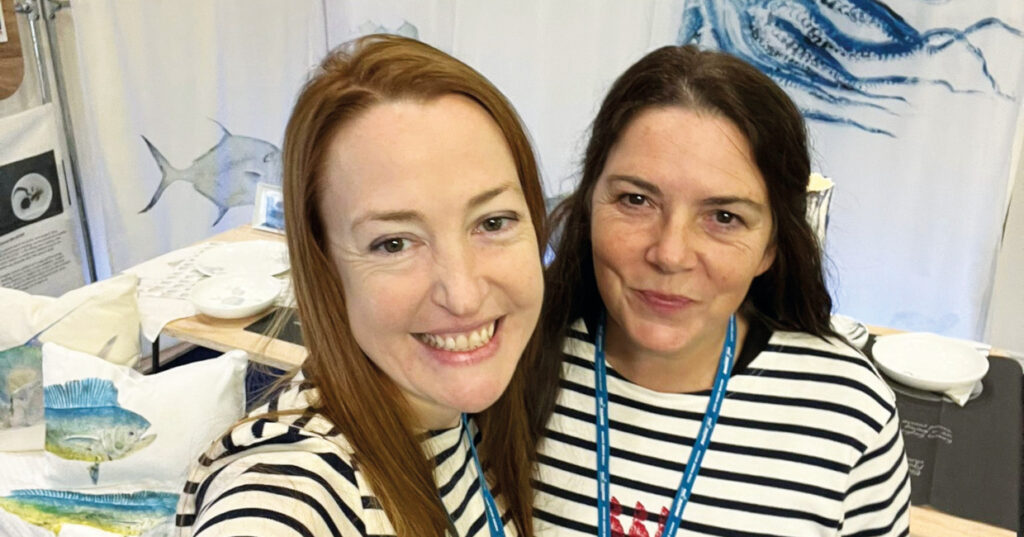After discovering that they were exploring the same unusual but striking Japanese artform, Jessica Felby and Lisa Lee Herman decided to join forces to begin a new venture printing their stunning designs onto a range of products. With those products now available to the hospitality industry, Vicky Doe met the inspirational artists to find out how TAKU+TAKU came to life.
The joy and passion that both Jessica Felby and Lisa Lee Herman feel for their work emanates throughout their very beings, so much so that it translated through our trans-Atlantic online call and I could not help but become swept up in it too!
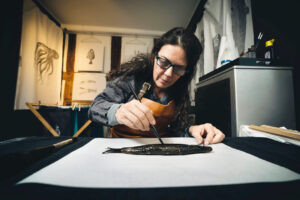 Jessica and Lisa couldn’t be further away from each other, geographically (Jessica is based on a small Danish-owned island off the coast of Sweden and Lisa’s studio is also on a small island, but just south of Miami in the Florida Keys) they could not be closer, artistically. They both practice the art of Gyotaku – a Japanese word meaning fish rubbing or fish printing – but both came at it from different angles.
Jessica and Lisa couldn’t be further away from each other, geographically (Jessica is based on a small Danish-owned island off the coast of Sweden and Lisa’s studio is also on a small island, but just south of Miami in the Florida Keys) they could not be closer, artistically. They both practice the art of Gyotaku – a Japanese word meaning fish rubbing or fish printing – but both came at it from different angles.
Jessica went to art school to study design in Sheffield and particularly worked on packaging design. She went on to work in corporate sites, including in Belgium at Coca Cola’s European head office and at agencies in Canada and the US. She came to Copenhagen to head up design for the Carlsberg Group where she worked on the global branding for the company. When the pandemic hit, she moved with her family to the island she now calls home – Bornholm – the first island in the world and first region in Europe to become a World Craft Region. As an old fishing island, the location meant that Jessica was perfectly positioned to begin to explore the artform, Gyotaku, that she had seen in Japan. The time that the pandemic afforded her allowed her to fully explore the medium and she, and her family, chose to remain on the island post-covid and set up a studio and gallery there.
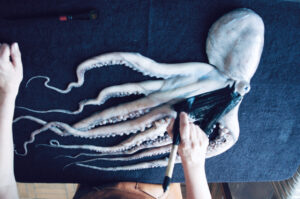 Lisa experienced a similar pandemic-induced life change over in Florida. Having been a part-time artist and part-time piano teacher, lockdown meant that piano lessons came to a halt and customers no longer came into her studio. She explained that she had heard about this artform, but the time she found herself with allowed her to explore it further: “I’ve always been interested in this style of art, but it being a Japanese style of art I was unsure how to even approach. So when lockdown happened, the whole island shut down so all we did was go fishing I thought, well this is the time I’m really going to try it out. I’d tried in in high school butI didn’t know about the correct papers or anything about inks back then. So fast forward with all my art school experience under my belt and a lot of extra time on my hands, I was able to get back to it. So we went out fishing, I caught a little yellow tail and started practising and I thought to myself, this is it. This is the next avenue.” Post-covid, Lisa found a new gallery location that was accessible to tourists, particularly, and the interest in her work has soared.
Lisa experienced a similar pandemic-induced life change over in Florida. Having been a part-time artist and part-time piano teacher, lockdown meant that piano lessons came to a halt and customers no longer came into her studio. She explained that she had heard about this artform, but the time she found herself with allowed her to explore it further: “I’ve always been interested in this style of art, but it being a Japanese style of art I was unsure how to even approach. So when lockdown happened, the whole island shut down so all we did was go fishing I thought, well this is the time I’m really going to try it out. I’d tried in in high school butI didn’t know about the correct papers or anything about inks back then. So fast forward with all my art school experience under my belt and a lot of extra time on my hands, I was able to get back to it. So we went out fishing, I caught a little yellow tail and started practising and I thought to myself, this is it. This is the next avenue.” Post-covid, Lisa found a new gallery location that was accessible to tourists, particularly, and the interest in her work has soared.
What is Gyotaku?
For those less familiar with this artform, it was originally used by Japanese fisherman for recording their catch in the 1800s. Rumour has it that samurais would settle fishing competitions using gyotaku. Now a recognised artform of its own, the method of printmaking uses fish, sea creatures or similar subjects as ‘printing plates’. Ink (usually sumi ink) is painted directly onto the body of the sea creature and a print is taken from it using fine fabrics (traditionally washi paper) – the brush only touches the fish, not the finished print.
Creation of Taku+Taku
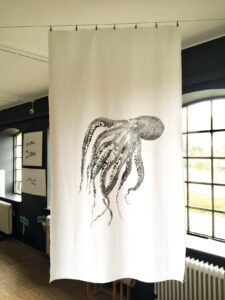 So having mastered this unique style of art, how did both Jessica and Lisa find themselves in the market? Jessica explained: “I had a design background and I found that just creating the art didn’t take it far enough. Not everybody’s in the market for buying a big print. And so to make it much more accessible, I put the art onto products. I started working with a pottery company and we made some beautiful products with them. We create an entire visual entity from a couple of core elements. We can use one print and create bespoke images from that – we can shrink it down, blow it up, crop it in, or even tessellate it to make a textile. One piece of art can make 50 different prints.” This is clearly evident from the products available from my favourite print – the octopus! Jessica utilised different parts of the print to create a full range of products featuring the octopus, all clearly linked as part of the same piece of art, but all individual at the same time.
So having mastered this unique style of art, how did both Jessica and Lisa find themselves in the market? Jessica explained: “I had a design background and I found that just creating the art didn’t take it far enough. Not everybody’s in the market for buying a big print. And so to make it much more accessible, I put the art onto products. I started working with a pottery company and we made some beautiful products with them. We create an entire visual entity from a couple of core elements. We can use one print and create bespoke images from that – we can shrink it down, blow it up, crop it in, or even tessellate it to make a textile. One piece of art can make 50 different prints.” This is clearly evident from the products available from my favourite print – the octopus! Jessica utilised different parts of the print to create a full range of products featuring the octopus, all clearly linked as part of the same piece of art, but all individual at the same time.
I was keen to find out how the newly formed company works. Jessica explained: “When we met at the world conference for the Nature Printing Society, we hit it off right away. We realised that what we were doing really complemented each other’s work and rather than both of us trying to do the same thing in different countries, and competing or hiding what we’re doing, we said ‘Wouldn’t it be better if we collaborated?’ Our skills are like a Venn diagram – Lisa has the fishing experience and she has an intensely great artist’s background whereas mine is a bit more design. I went to art school, but it was more design-based. I have a much more commercial background with knowledge in product creation along with a product design degree. So it was perfect!”
So Taku+Taku was born – the name derives from the name of the artform itself, although the team are now branching out and not only printing fish – their latest pieces include other areas of nature; feathers, trees and floral prints are also now available. What is from these prints are unique, authentic, bespoke, sustainable luxury products which would be perfectly placed within a hospitality, particularly F&B, setting.
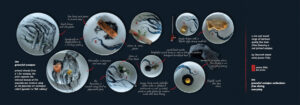 Products available include fabric work – napkins, curtains, cushions, lampshades; tableware – plates, bowls, cups, as well as prints of a range of sizes. Bespoke items can be created by the team according to a customer’s needs. Jessica told me about a specific request from a recent customer: “A mountain resort wanted to look at the idea of using prints of their trees on some of their products. I created prints of different tree trunks around the resort and we created prototypes of products using their very own trees – tablewares, décor, linens, even graphics which we put on the menus. This is something we can explore with different requests – a chef recently asked us for cabbage prints for his tableware which we created. We love creating these bespoke hospitality projects with customers and bringing their vision to life. We can print almost anything, almost anywhere!”
Products available include fabric work – napkins, curtains, cushions, lampshades; tableware – plates, bowls, cups, as well as prints of a range of sizes. Bespoke items can be created by the team according to a customer’s needs. Jessica told me about a specific request from a recent customer: “A mountain resort wanted to look at the idea of using prints of their trees on some of their products. I created prints of different tree trunks around the resort and we created prototypes of products using their very own trees – tablewares, décor, linens, even graphics which we put on the menus. This is something we can explore with different requests – a chef recently asked us for cabbage prints for his tableware which we created. We love creating these bespoke hospitality projects with customers and bringing their vision to life. We can print almost anything, almost anywhere!”
So with the move now into supplying across hospitality businesses, how do they envisage the next steps for the brand looking? “We’ve had so much interest from the hospitality industry,” said Jessica. “We’ve had people saying ‘Wow, this should really be in a restaurant!” so we’ve been connecting with various suppliers and launching our products across the sector this spring.”
With interest coming from across the industry, including cruise ship interiors, it’s clear that it won’t be long before this dynamic duo have products in place at F&B establishments across the world. I, for one, will be following the developments of this fledgling brand with interest and will be waiting with bated breath to see what happens next for them.


